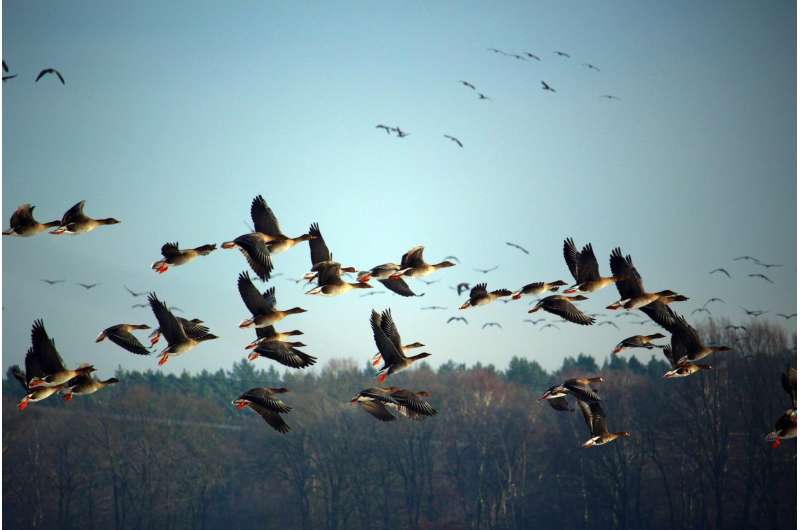Credit: CC0 Public Domain
A team of researchers at Lund University has found evidence that suggests a certain protein plays a prominent role in bird navigation. They have published their findings in Journal of the Royal Society Interface.
Birds that are able to migrate great distances obviously have some form of navigation system—they stop at the same places and have very clear destinations in mind. But how do they do it? In recent years, some in the field believed it had to do with iron-rich cells in their beaks serving as mini-compasses, but this theory has had some problems, such as how the birds translate beak sensations to directional signals. In this new effort, the researchers suggest it is not the cells in the beak that are responsible, but a type of protein that exists in their eyes. The researchers came to this conclusion by studying the brains, muscles and eyes of zebra finches. More specifically, they studied Cry1, Cry2 and Cry4, proteins associated with the circadian clock. The researchers found that Cry1 and Cry2 levels tend to rise and fall throughout each day, but Cry4 remains constant, suggesting it has another purpose.
The researchers chose to study these particular proteins because they are made of a type of molecule that sometimes has an odd number of electrons, leaving some unpaired, and thus sensitive to a magnetic field. They also found that Cry4 tends to exist in clusters in a part of the bird retina that tends to get a lot of light and which is sensitive to blue light—this is important because prior studies have shown that birds are only able to navigate when blue light is available. Taken together, the evidence suggests that the protein plays a strong role in navigation.
The study does not prove that the Cry4 protein is the key to bird navigation, but it makes a strong case for it. Earlier this month, a Danish and German team of researchers studying robins found that Cry4 levels also remain constant each day, but rise during the migratory season.
More information: Atticus Pinzon-Rodriguez et al. Expression patterns of cryptochrome genes in avian retina suggest involvement of Cry4 in light-dependent magnetoreception, Journal of The Royal Society Interface (2018). DOI: 10.1098/rsif.2018.0058
Abstract
The light-dependent magnetic compass of birds provides orientation information about the spatial alignment of the geomagnetic field. It is proposed to be located in the avian retina, and be mediated by a light-induced, biochemical radical-pair mechanism involving cryptochromes as putative receptor molecules. At the same time, cryptochromes are known for their role in the negative feedback loop in the circadian clock. We measured gene expression of Cry1, Cry2 and Cry4 in the retina, muscle and brain of zebra finches over the circadian day to assess whether they showed any circadian rhythmicity. We hypothesized that retinal cryptochromes involved in magnetoreception should be expressed at a constant level over the circadian day, because birds use a light-dependent magnetic compass for orientation not only during migration, but also for spatial orientation tasks in their daily life. Cryptochromes serving in circadian tasks, on the other hand, are expected to be expressed in a rhythmic (circadian) pattern. Cry1 and Cry2 displayed a daily variation in the retina as expected for circadian clock genes, while Cry4 expressed at constant levels over time. We conclude that Cry4 is the most likely candidate magnetoreceptor of the light-dependent magnetic compass in birds.
Journal information: Journal of the Royal Society Interface
© 2018 Phys.org























